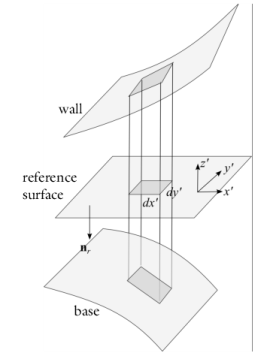The Navier-Stokes equations can be nondimensionalized for a domain whose width (h0) is much smaller than its lateral dimension(s) (
l0) (see
Ref. 1 for a detailed discussion). When
Re(
h0/
l0)
2<<1, and terms of order (
h0/
l0)
2 are neglected, the Navier-Stokes equations reduce to a modified form of the Stokes equation, which must be considered in conjunction with the continuity relation.
The equations are most conveniently expressed by considering a local coordinate system in which x’ and
y’ are tangent to the plane of the reference surface, and
z’ is perpendicular to the surface, as illustrated in
Figure 4-5. Using this coordinate system:
Here pf is the pressure resulting from the fluid flow,
μ is the fluid viscosity, and (
vx’,
vy’) is the fluid velocity in the reference plane (which varies in the
z’ direction).
The constants C1x’,
C2x’,
C1y’, and
C2y’ are determined by the boundary conditions.
Equation 4-4 shows that the flow is a linear combination of laminar Poiseuille and Couette flows. The velocity profile is quadratic in form, as shown in
Equation 4-5.
The forces acting on the walls are determined by the normal component of the viscous stress tensor, τ, at the walls (
τn - where
n is the normal that points out of the fluid domain). The viscous stress tensor takes the form:
Neglecting the gradient terms, which are of order h0/
l0, results in the following form for the stress tensor:
The components of the stress tensor can be expressed in terms of the velocity and pressure gradients using Equation 4-4. Note that the normals to both the wall and the base are parallel to the
z’ direction, to zeroth order in
h0/
l0. The forces acting on the base and the wall are therefore given by:
Assuming a slip length of Lsw at the wall and a slip length of
Lsb at the base, the general slip boundary conditions are given by:
For non-identical slip lengths the constants C1x’,
C2x’,
C1y’, and
C2y’ take the following values:
where vav,c is a term associated with Couette flow, and
vav,p is a coefficient associated with Poiseuille flow (see
Table 4-2 below).
Note that the z’ direction corresponds to the
−nr direction. The
x’ and
y’ directions correspond to the two tangent vectors in the plane. Using vector notation the forces become:
In Equation 4-8 it is assumed that
nw=
−nr and
nb=
nr. In COMSOL Multiphysics, the accuracy of the force terms is improved slightly over the usual approximation (which neglects the slope of the wall and base as it is of order
h0/
l0) by using the following equations for
nw and
nb:
These definitions are derived from Equation 4-4 and
Equation 4-5 and include the additional area that the pressure acts on as a result of the wall slope.
where fw,p is the Poiseuille coefficient for the force on the wall, and
fw,c incorporates the Couette and normal forces (due to the pressure) on the wall. Similarly,
fb,p is the Poiseuille coefficient for the force on the base, and
fb,c incorporates the Couette and normal forces (due to the pressure) on the base.
